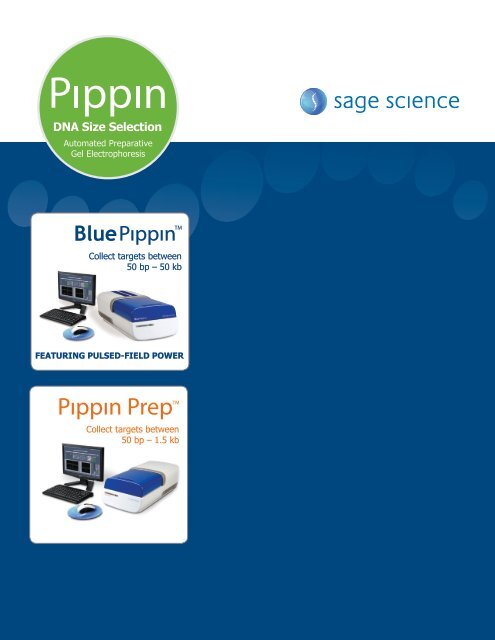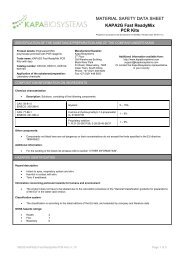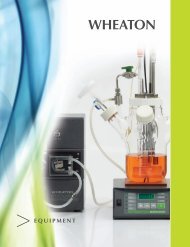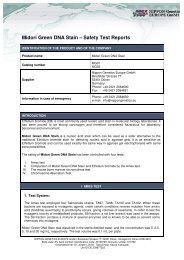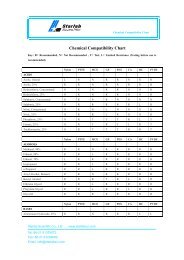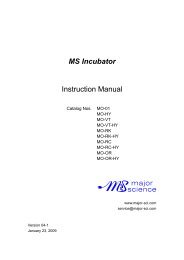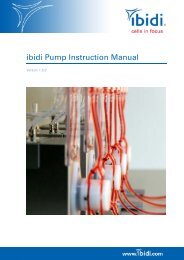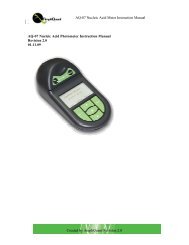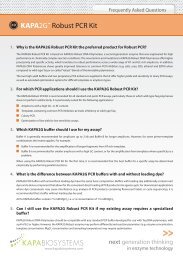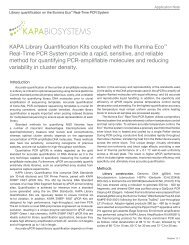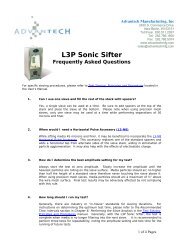DNA Size Selection
DNA Size Selection
DNA Size Selection
Create successful ePaper yourself
Turn your PDF publications into a flip-book with our unique Google optimized e-Paper software.
<strong>DNA</strong> <strong>Size</strong> <strong>Selection</strong><br />
Automated Preparative<br />
Gel Electrophoresis<br />
Collect targets between<br />
50 bp – 50 kb<br />
FEATURING PULSED-FIELD POWER<br />
Collect targets between<br />
50 bp – 1.5 kb
<strong>DNA</strong> <strong>Size</strong> <strong>Selection</strong><br />
An Automated Alternative to Manual Prep Gels<br />
Pippin instruments are the best alternative to excising <strong>DNA</strong> from agarose slab gels and purifying with<br />
kits. In addition to signicant savings in labor and eort, users see a better yield of higher-quality <strong>DNA</strong><br />
than is possible with manual gels. Independent studies show that automated size selection with Pippin<br />
is more precise, reproducible, and higherthroughput than is possible with manual gels.<br />
We oer the Pippin Prep for reproducible collections of smaller fragments, up to 1.5 kb. Our BluePippin<br />
facilitates the collection of larger fractions, up to 50 kb.<br />
Key application areas:<br />
• Library construction for paired-end sequencing<br />
• Template preparation for clonal amplication of<br />
<strong>DNA</strong> on beads<br />
• Library construction for Chromatin<br />
Immunoprecipitation (ChIP) techniques<br />
• Isolation of miRNA libraries from adapter<br />
dimer and larger c<strong>DNA</strong>s<br />
Benets of the Pippin <strong>DNA</strong> size<br />
selection system:<br />
• Minutes of labor saves time compared to<br />
manual gel purication<br />
• Provides narrow fragment size distributions<br />
• Minimal low molecular weight contamination<br />
reduces wasted reads and ambiguous<br />
indel calling<br />
• Individual sample channels allow for multiplexing<br />
without sample cross-contamination<br />
• Reproducible extractions provide more<br />
consistent results<br />
• Automated collection of PCR bands or<br />
restriction fragments<br />
vs.
Manual Gels<br />
Pippin Prep<br />
The Advantages of Narrow <strong>Size</strong> Distributions for <strong>DNA</strong> Sequencing<br />
Pippin size selection provides a narrow and uniform <strong>DNA</strong> fragment size distribution, with minimal LMW contamination.<br />
This provides key advantages to single-end and paired-end sequencing. For bead-based systems, a tightly sized library<br />
reduces amplication bias toward smaller fragments, providing a more ecient sequencing run. For paired-end sequencing,<br />
narrow size distributions provide optimal libraries for identifying indels and other structural variants.<br />
Select and Collect<br />
<strong>Size</strong> select <strong>DNA</strong> by entering a base pair target value, and the Pippin will collect the narrowest (Tight) distribution of<br />
fragments possible centered on the target size. <strong>DNA</strong> may also be collected by entering a base pair range up to the<br />
allowable range of the gel cassette.<br />
Specifications<br />
Gel Cassettes:<br />
Target Range<br />
3.0% Agarose 90 bp – 250 bp<br />
2.0% Agarose 100 bp – 600 bp<br />
1.5% Agarose 250 bp – 1500 bp<br />
0.75% Agarose (Pippin Prep) 2 kb – 8 kb<br />
0.75% Agarose (BluePippin) 1 kb – 50 kb<br />
Instruments:<br />
Optical Detection<br />
Power<br />
Weight<br />
Dimensions<br />
Pippin Prep: 535 nm excitation, 640 nm emission<br />
BluePippin: 470 nm excitation, 525 nm emission<br />
100-240 VAC, 2.5 A, 50-60 Hz<br />
15 lbs / 7 kg<br />
7h x 11w x 21d (in), 18h x 28w x 53 d (cm)
How the System Works<br />
sample 2<br />
sample sample 2 1<br />
sample 1<br />
sample 1<br />
<strong>DNA</strong> is electroeluted<br />
Pippin gel cassettes are pre-cast with<br />
from agarose<br />
agarose and are disposable. Sizing is into buffer<br />
<strong>DNA</strong> size ladder<br />
determined by the detection of <strong>DNA</strong><br />
markers run in one dedicated lane, or<br />
Collection Chamber<br />
Collection Chamber<br />
sample 4<br />
in some cases (on the BluePippin) by<br />
Impermeable Collection Collection Membrane Chamber Chamber<br />
Impermeable Membrane<br />
Impermeable Membrane<br />
running internal standards within the<br />
sample lanes. Sample capacity is 4 or sample 5 3<br />
lanes, depending on cassette type and <strong>DNA</strong> size ladder<br />
electrophoresis protocol.<br />
sample 2<br />
Each sample lane is physically separate,<br />
sample 4<br />
and features a branched configuration<br />
sample 1<br />
to which 3 electrodes are applied. <strong>DNA</strong><br />
sample 3<br />
is separated along a gel column until the<br />
programmed fragment range reaches<br />
the branch point. By switching the<br />
sample 2<br />
active electrode, <strong>DNA</strong> is diverted into<br />
a membrane-bound buffer chamber.<br />
sample 1<br />
When the size range has been collected,<br />
the active electrode is switched back to<br />
the separation channel, and the sample<br />
can be removed with a standard pipette. Collection Chamber<br />
Impermeable Membrane<br />
-<br />
+<br />
+ +<br />
-<br />
+<br />
+<br />
- +<br />
- +<br />
+<br />
+<br />
-<br />
+ +<br />
-<br />
-<br />
+<br />
Separation Channel<br />
+<br />
Elution Channel<br />
-<br />
+<br />
-<br />
+<br />
+<br />
-<br />
+<br />
+<br />
-<br />
+<br />
+<br />
-<br />
+<br />
+<br />
-<br />
+<br />
+<br />
-<br />
-<br />
+<br />
-<br />
+<br />
+<br />
Separation Channel<br />
+<br />
Elution Channel<br />
+<br />
Separation Separation Channel Channel<br />
Separation Channel<br />
Each lane has<br />
Elution Channel<br />
+ Elution Elution Channel switchable Channel electrodes<br />
Separation Channel<br />
Elution Channel<br />
+<br />
+<br />
+<br />
Each lane has<br />
switchable elect<br />
In the Literature:<br />
Collection Chamber<br />
Impermeable Membrane<br />
Separation Channel<br />
“Of the three sizing fractionation methods tested for target recovery efficiency, throughput, and risk of<br />
cross-sample contamination, Pippin Prep, an automated optical electrophoretic system that does not<br />
require gel extraction, was the most efficient and reproducible, with the tightest, most specific sizing.”<br />
Elution Channel<br />
— Extracted from Duhaime et al. “Towards quantitative metagenomics of wild viruses and other ultra-low concentration<br />
<strong>DNA</strong> samples: a rigorous assessment and optimization of the linker amplification method,” Environmental Microbiology<br />
(2012) 14(9), 2526–2537.<br />
“Bioanalyzer results suggested that [Pippin] automated size-selection libraries were substantially more<br />
consistent than gel extraction libraries. In contrast to automated size-selected samples, gel excision<br />
samples did not appear to saturate in the range of coverage observed. This is likely because size<br />
selection was imprecise or ‘leaky,’ with substantial representation of fragments of lengths relatively<br />
distant from the size-selection target mean. Careful practitioners can achieve roughly 50% of the<br />
precision and repeatability of automated <strong>DNA</strong> size selection.”<br />
— Extracted from Peterson et al. “Double Digest RADseq: An Inexpensive Method for De Novo SNP Discovery and<br />
Genotyping in Model and Non-Model Species,” PLoS ONE 7(5): e37135. doi:10.1371/journal.pone.0037135<br />
978.922.1832 // www.sagescience.com<br />
© 2012 Sage Science, Inc. Pippin Prep is a trademark of Sage Science, Inc.


